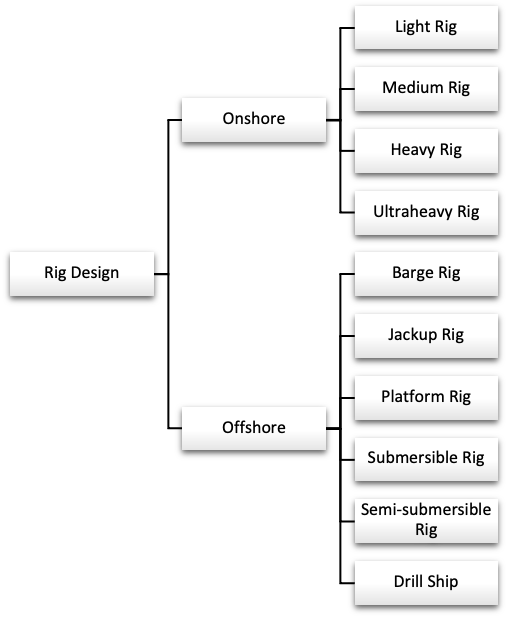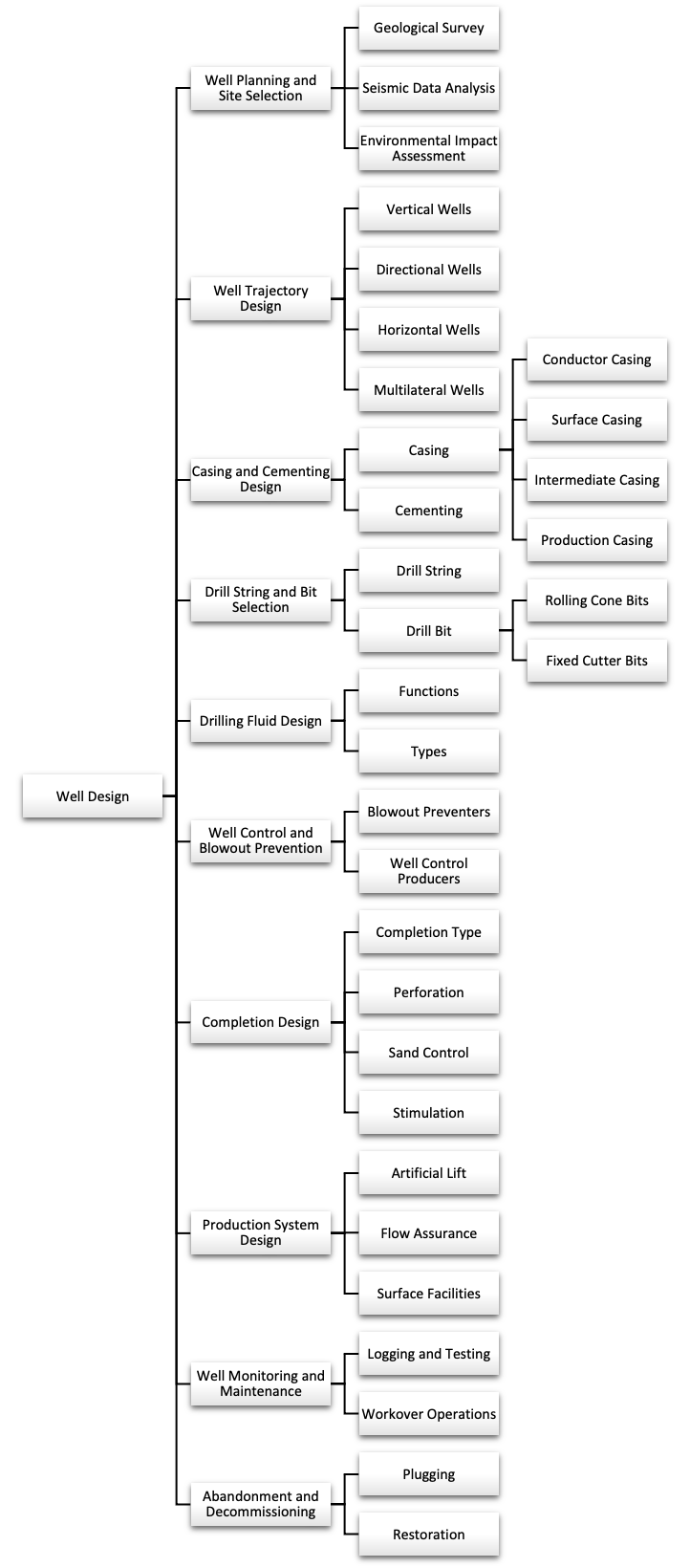Drilling Engineering
Oil and gas drilling is the process of creating holes in the earth's surface to extract hydrocarbons (oil and natural gas) from underground reservoirs. This process involves several key stages and technologies, including exploration, drilling, and production. Oil and natural gas lie deep below the earth’s surface, making the drilling process quite complex. One has to drill a hole through the earth’s crust to reach the fossil fuel deposits. Next, the oil must get pumped out of the oil well while maintaining safety.
Science Branches |
| Science |
| Applied Science |
| Engineering |
| Mechanical Engineering |
- See Articles - List of Tags, List of Categories, List of Articles, List of Glossaries, Nomenclature and Symbols, (See Drilling Glossary)
Drilling Production Stages
Drilling Rig Design Classification
Onshore - An onshore drilling operation can take place in two categories. One of the ways is mobile, which features a truck or trailer mounted rig. The other category is a conventional rig, which is stationary. These rigs are based on the drilling depths.
- Light Rig - depth 3,000 to 5,000 feet, 650 Hp
- Medium Rig - depth 4,000 to 10,000 feet, 1,300 Hp
- Heavy Rig - depth 12,000 to 16,000 feet, 2,000 Hp
- Ultraheavy Rig - depth 18,000 to 25,000 feet or more, 3,000 Hp or more
 Offshore - An offshore drilling rig has to create the same working conditions as for onshore rigs which can move from one point to another without any difficulty, and they have several additional features to adapt them to the marine environment, including a helaport, living quarters, cranes, and risers.
Offshore - An offshore drilling rig has to create the same working conditions as for onshore rigs which can move from one point to another without any difficulty, and they have several additional features to adapt them to the marine environment, including a helaport, living quarters, cranes, and risers.
- Barge Rig - A drill barge is simple a barge equipped for oil and gas drilling, but compared to a drill ship it does not have its own propulsion system and must be towed to the drilling site by other vessels. The drill barge is used in inland, shallow or smooth offshore areas where the water depth is typically less than 20 feet.
- Jackup Rig - These rigs are well suited for shallow waters of 400 feet or less. As they are move into deeper waters, a mobile platform is needed. The rig can be self-elevated, with three or four movable legs that can be extended above or below the drilling deck, or hull. When the rig reaches the drill site, the crew jacks the legs downward through the water and into the sea floor. This anchors the rig and holds the drilling deck well above the waves.
- Platform Rig - These are normally located on the continental shelf in deep water up to 1,700 feet. They are made of steel or cement and intended to be permanent structures housing large facilities, heavy equipment, and big crews.
- Submersible Rig - They are barge that are designed to work in deeper water up to 50 feet deep. They have extensions that allow them to raise its upper hull above the water level.
- Semi-submersible Rig - These rigs are floating offshore drilling units with pontoons and columns that, when flooded with water, cause the unit to partially submerge to a predetermined depth. Most semi-submersibles are anchored to the sea bottom with mooring chains, but some use dynamic positioning, which allows the vessels to be held in position by computer-controlled propellers, known as thrusters.
- Drill Ship - They are much more like a traditional ship than jack-ups or semi-submersibles. They have a ship shape, run under their own power, and are able to operate in waters at 3,000 feet, while for greater depths dynamic positioning systems must be used, and with these the ship is capable of operating in 10,000 feet of water. Drill ships have a derrick mounted on deck with drilling equipment that passes through a moonpool in the bottom of the hull. The moonpool is a hole in the bottom of the hull that is covered during transit and uncovered for drilling, allowing drilling equipment to be mounted in the middle of the vessel and passed straight through the hull into the water.
Drilling Well Design
 Oil and gas well design is a complex process that involves several stages to ensure safe, efficient, and productive extraction of hydrocarbons. The design process includes various technical, environmental, and economic considerations. Below is an overview of the key components and stages of oil and gas well design.
Oil and gas well design is a complex process that involves several stages to ensure safe, efficient, and productive extraction of hydrocarbons. The design process includes various technical, environmental, and economic considerations. Below is an overview of the key components and stages of oil and gas well design.
Well Planning and Site Selection
- Geological Survey - Understanding the subsurface geology to identify potential hydrocarbon reservoirs.
- Seismic Data Analysis - Using seismic surveys to map underground formations.
- Environmental Impact Assessment - Evaluating the environmental implications and obtaining necessary permits.
Well Trajectory Design
- Vertical Wells - Drilled straight down to reach the reservoir.
- Directional Wells - Include deviations from vertical to reach different parts of the reservoir.
- Horizontal Wells - Extended horizontally within the reservoir to maximize contact with the hydrocarbon-bearing formation.
- Multilateral Wells - Multiple wellbore branches from a single well to enhance reservoir drainage.
Casing and Cementing Design
- Casing - Steel pipes installed in the wellbore to maintain well integrity, prevent collapse, and isolate different subsurface layers.
- Conductor Casing - First casing set near the surface.
- Surface Casing - Provides a foundation for blowout preventers.
- Intermediate Casing - Isolates different pressure zones.
- Production Casing - Runs through the productive formation.
- Cementing - Pumping cement between the casing and the wellbore to secure the casing and prevent fluid migration.
Drill String and Bit Selection
- Drill String - Comprises drill pipes, collars, and tools to transmit drilling fluid and rotate the bit.
- Drill Bit - Selected based on formation hardness and wellbore design.
- Roller Cone Bits - Suitable for soft to medium-hard formations.
- Fixed Cutter Bits (PDC bits) - Used for harder formations.
Drilling Fluid Design
- Functions - Removes cuttings, controls well pressure, lubricates and cools the bit, and stabilizes the wellbore.
- Types - Water-based mud, oil-based mud, and synthetic-based mud.
Well Control and Blowout Prevention
- Blowout Preventers (BOP) - Installed on the wellhead to control unexpected pressure surges.
- Well Control Procedures - Include mud weight adjustments and kick detection protocols.
Completion Design
- Completion Type - Open hole, cased hole, or liner completions.
- Perforation - Creating holes in the casing to connect the wellbore with the reservoir.
- Sand Control - Techniques like gravel packing or screens to prevent sand production.
- Stimulation - Hydraulic fracturing or acidizing to enhance well productivity.
Production System Design
- Artificial Lift - Methods like pumps or gas lift to enhance production if natural reservoir pressure is insufficient.
- Flow Assurance - Ensuring steady flow of hydrocarbons to the surface, preventing blockages due to hydrates, wax, or asphaltenes.
- Surface Facilities - Design of separators, storage tanks, and pipelines for handling produced fluids.
Well Monitoring and Maintenance
- Logging and Testing - Monitoring well integrity and performance through various logs and tests.
- Workover Operations - Interventions to repair, maintain, or enhance well productivity.
Abandonment and Decommissioning
- Plugging - Sealing the well with cement plugs to prevent fluid migration.
- Restoration - Restoring the site to its original condition or as per regulatory requirements.
Each stage of the well design process involves specialized engineering knowledge, regulatory compliance, and the application of advanced technologies to ensure the well is drilled safely and efficiently, with minimal environmental impact.

Tags: Mechanical Pump Petroleum Storage Tank and Pressure Vessel Engineering Drilling Design Classification Annular Drilling Mud Drilling Bit Drilling Cement Drilling Pump Drill Pipe


 Well Completion
Well Completion